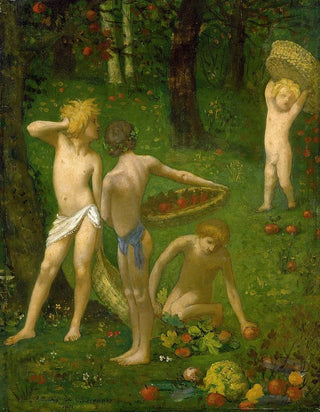Art print | Children in an Orchard - Pierre Puvis de Chavannes


View from behind

Frame (optional)
In the enchanting world of art, certain works stand out for their ability to capture innocence and the beauty of simple moments in life. "Children in an Orchard" by Pierre Puvis de Chavannes is one of those creations that evoke a bucolic and nostalgic atmosphere. This canvas, created at the end of the 19th century, depicts children playing in a lush orchard, surrounded by ripe fruits and verdant foliage. The piece transports the viewer to a world where nature and childhood intertwine, revealing a vivid tableau of wonder and joy. The art print of Children in an Orchard by Pierre Puvis de Chavannes allows for rediscovering this scene imbued with delicacy and harmony, offering an invitation to daydreaming.
Style and uniqueness of the work
Puvis de Chavannes' style is characterized by a unique and poetic approach, blending realism with a certain idealization. In "Children in an Orchard," he manages to create an atmosphere that is both serene and vibrant. The pastel colors, soft and luminous, blend harmoniously, while light plays an essential role in the composition. The children, depicted with great tenderness, are both symbols of innocence and emblematic figures of childhood. The arrangement of the characters in the orchard, as well as their interaction with nature, suggests a deep connection between man and his environment. This work stands out for its ability to evoke universal emotions, making each gaze at the canvas unique and personal.
The artist and his influence
Pierre Puvis de Chavannes, an emblematic figure of the symbolist movement, left a mark on art history with his innovative approach. Born in 1824, this French artist established himself with a distinctive style that combines classical elements and modernity. Influenced by the great masters of the Renaissance, Puvis de Chavannes developed a visual language that is his own, characterized by balanced compositions and a delicate color palette. His work inspired many artists, particularly in the field of muralism, where his use of

Matte finish

View from behind

Frame (optional)
In the enchanting world of art, certain works stand out for their ability to capture innocence and the beauty of simple moments in life. "Children in an Orchard" by Pierre Puvis de Chavannes is one of those creations that evoke a bucolic and nostalgic atmosphere. This canvas, created at the end of the 19th century, depicts children playing in a lush orchard, surrounded by ripe fruits and verdant foliage. The piece transports the viewer to a world where nature and childhood intertwine, revealing a vivid tableau of wonder and joy. The art print of Children in an Orchard by Pierre Puvis de Chavannes allows for rediscovering this scene imbued with delicacy and harmony, offering an invitation to daydreaming.
Style and uniqueness of the work
Puvis de Chavannes' style is characterized by a unique and poetic approach, blending realism with a certain idealization. In "Children in an Orchard," he manages to create an atmosphere that is both serene and vibrant. The pastel colors, soft and luminous, blend harmoniously, while light plays an essential role in the composition. The children, depicted with great tenderness, are both symbols of innocence and emblematic figures of childhood. The arrangement of the characters in the orchard, as well as their interaction with nature, suggests a deep connection between man and his environment. This work stands out for its ability to evoke universal emotions, making each gaze at the canvas unique and personal.
The artist and his influence
Pierre Puvis de Chavannes, an emblematic figure of the symbolist movement, left a mark on art history with his innovative approach. Born in 1824, this French artist established himself with a distinctive style that combines classical elements and modernity. Influenced by the great masters of the Renaissance, Puvis de Chavannes developed a visual language that is his own, characterized by balanced compositions and a delicate color palette. His work inspired many artists, particularly in the field of muralism, where his use of






